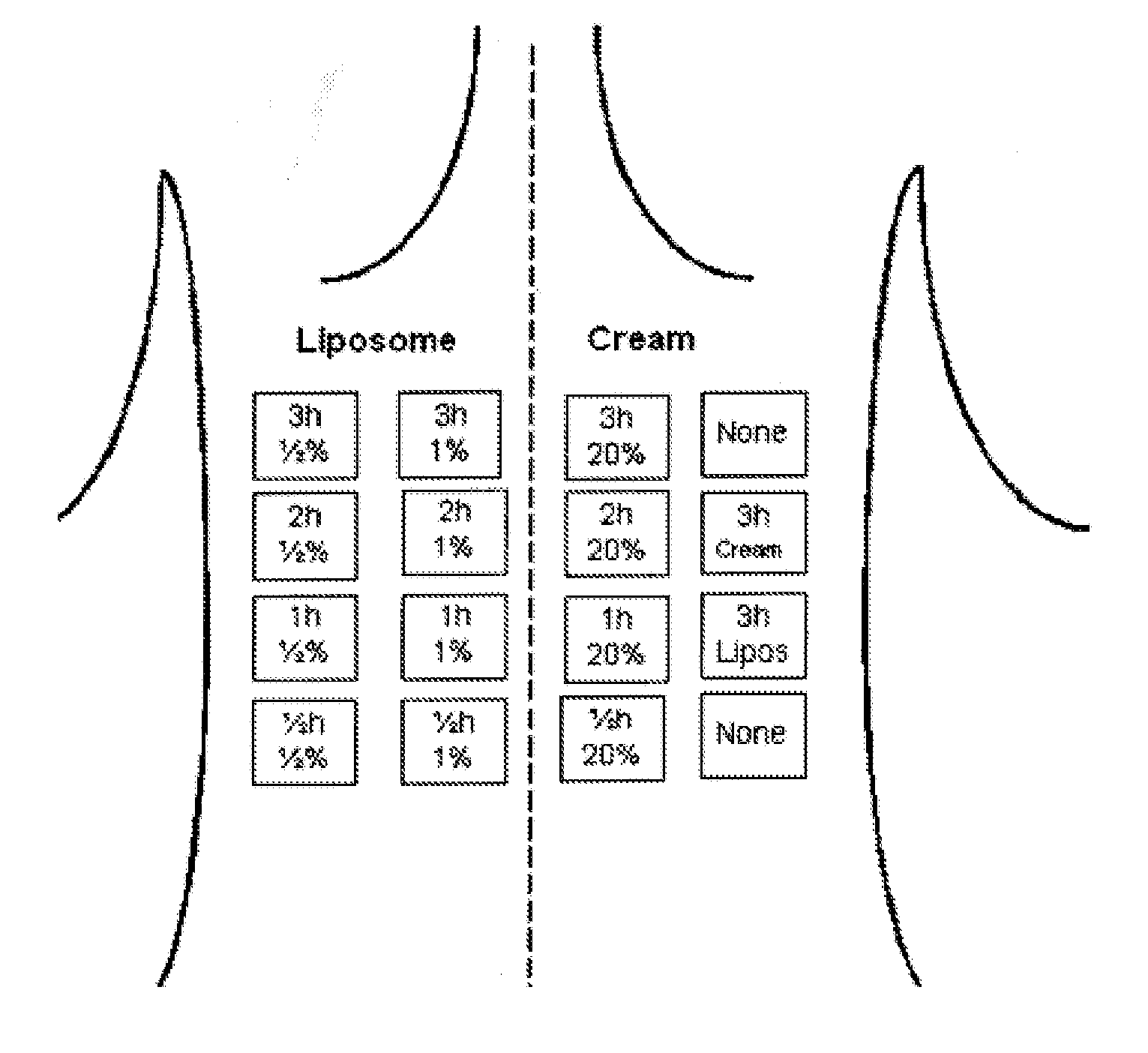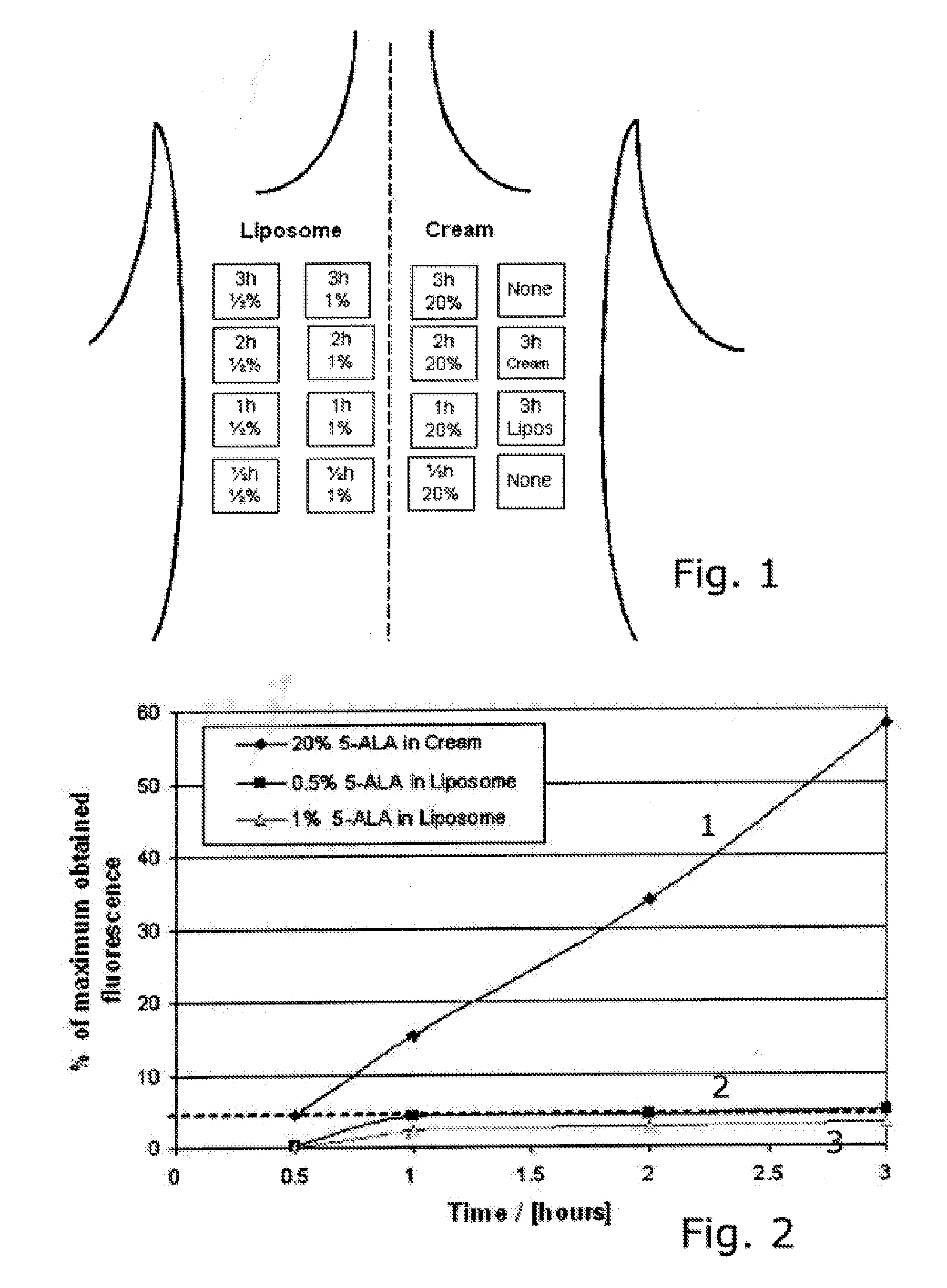Method for non-therapeutic or therapeutic photodynamic skin treatment
a non-therapeutic or therapeutic technology, applied in the direction of biocide, medical devices, plant growth regulators, etc., can solve the problems of accompanied side effects, relatively long treatment duration, and the beneficial effects of photodynamic treatment, and achieve the effect of significantly reducing the inconvenience of prior art procedures
- Summary
- Abstract
- Description
- Claims
- Application Information
AI Technical Summary
Benefits of technology
Problems solved by technology
Method used
Image
Examples
example 1
[0069]A clinical multi-centre study of the effect of the method according to the invention to facial wrinkle reduction using 0.5% 5-ALA liposome preparation was attended to and finalized by 20 volunteers with ages ranging from 37 to 70 years and Fitzpatrick skin type varying from 1 to IV. Suntan in the treated areas was between none to heavy. The volunteers had visible periorbital and / or perioral wrinkles, on Fitzpatrick's wrinkle scale, periorbital wrinkles around the eyes averaged 5.88 and perioral wrinkles (around the mouth averaged 5.48. All patients were instructed to avoid sun exposure and use efficient sun protection every morning and prior to out door activities in sunny weather.
[0070]Wrinkle severity according to Fitzpatrick's wrinkle scale was evaluated before the start of the treatment and at 1 and 3 months post treatment follow-up sessions with the results for reduction in periorbital wrinkles and perioral wrinkles shown in the diagrams in FIGS. 6 and 7, respectively.
[00...
example 2
[0074]A clinical multi-centre study using 0.5% 5-ALA liposome preparation was finalized by a total number of 27 volunteers in the age range from 25 to 70 years and belonging to Fitzpatrick skin types I to III with a degree of suntan in the treated skin areas varying from none to heavy. The volunteers had visible periorbital and perioral wrinkles and / or fine lines and suffered from sun damages skin with benign vascular and pigmented lesions.
[0075]The volunteers finalizing the study were divided into three groups comprising 10, 8 and 9 volunteers, respectively, treated at individual clinical sites in Denmark, Sweden and The Netherlands.
[0076]The volunteers in group 1 received a full face spraying with a 0.5% 5-ALA liposome spray delivered in 8 spray doses with intervals of 15 minutes for an overall duration of 2 hours immediately followed to exposure to light energy using the standard IPL (Intensified Pulse Light) equipment ELLIPSE® from Danish Dermatologic Development A / S. One side o...
example 3
[0084]The relative long lasting spraying period used in example 2 may be a disadvantage for a combined treatment modality. In this study we investigated the possibilities for shorten the spraying period by decreasing the intervals between spraying, and still obtain the same degree of fluorescence. The shortest practical possible time between two sprayings avoiding spraying wet in wet, is approximate 5 minutes. Therefore we have in this study chosen to compare obtained fluorescence after 5 min and 15 min spraying intervals. This study was performed as a split face study with random chosen spraying side for 15 min and 5 min which means the volunteers acts as their own control. 10 volunteers with Caucasian skin types were enrolled. Spraying was continued in two hours.
[0085]This study is based on fluorescence measurements performed under spraying normal facial skin with 0.5% liposome encapsulated 5-ALA, as well as in a period lasting up to 2 hours after end spraying. The test area has t...
PUM
| Property | Measurement | Unit |
|---|---|---|
| wavelength range | aaaaa | aaaaa |
| mean vesicle diameter | aaaaa | aaaaa |
| time | aaaaa | aaaaa |
Abstract
Description
Claims
Application Information
 Login to View More
Login to View More - R&D
- Intellectual Property
- Life Sciences
- Materials
- Tech Scout
- Unparalleled Data Quality
- Higher Quality Content
- 60% Fewer Hallucinations
Browse by: Latest US Patents, China's latest patents, Technical Efficacy Thesaurus, Application Domain, Technology Topic, Popular Technical Reports.
© 2025 PatSnap. All rights reserved.Legal|Privacy policy|Modern Slavery Act Transparency Statement|Sitemap|About US| Contact US: help@patsnap.com



